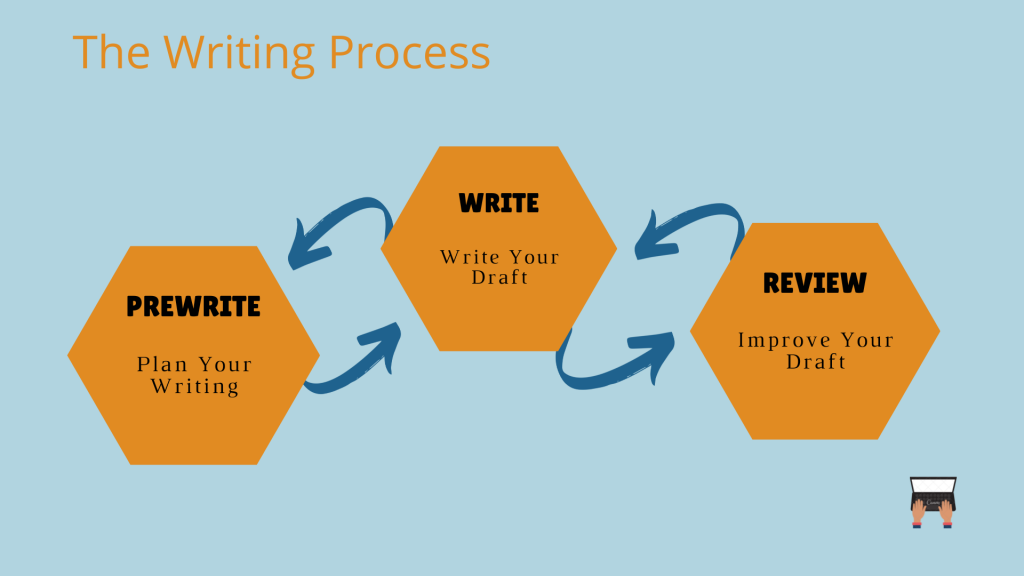2.1 Introduction
To write successfully, you need to pre-write, think, research, plan, organize, draft, revise, rethink, analyze and brainstorm. Why is it important to think of writing as more than just the act of physically writing out words? Because often when people say that they’re “bad at writing,” they actually just need to make a few adjustments to just one of the phases of the writing process. The more you understand your writing process, the more control you have over it.
The writing process is made up of three main parts as illustrated in Figure 2.1.

Pre-writing: In the prewriting stage, you might read an assignment prompt, research, make an outline, sketch some ideas, brainstorm, doodle, jot down notes or even just think about your writing topic.
Writing: In the writing or drafting stage, you write down words. Your writing task will determine how you write. Some people write long or important documents by composing them in a notebook and then typing out the final product. Some write in one long paragraph and then break it up in the revision stage.
Revision: After you’ve finished writing, it’s time to rethink your piece. Many students think that revising is just making grammatical changes, but it’s a lot more than that. Expert writers often spend most of their composition time on revision. They may rethink their strategy, try a new outline, show their work to a colleague to get feedback, read their work out loud to see where it sounds choppy or simply put the work away for a few hours so that they can come back to it with a fresh perspective.
It’s important to note that your writing process won’t be a straight line. Expert writers switch between different modes. For example, you might realize that you need more research and go back to the pre-writing process. You might revise and write as you go. You might show a draft to a colleague or friend and decide to reorganize the entire work based on their feedback. Sometimes, this back-and-forth feels frustrating to new writers, but it’s a normal part of the writing process.
Here are some ideas to switch up your writing process if you’re getting stuck. They can be used both in school and in the workplace.
Ways To Switch Up Your Writing Process
Pre-Writing
- Read the assignment prompt, then quickly write down 5 things you’ll need to do to be successful in the assignment. Using this list and the assignment prompt, create a timeline for finishing the assignment. For example, if you’re being graded on using primary and secondary research, you’ll want to make time to research, analyze your sources and add your citations.
- Go for a walk (or do some exercise) and think about your writing task. Sometimes moving your body helps you do brainstorming.
- Create an outline for your work.
- Use brainstorming (mind mapping, bubble maps, etc).
- Try illustrating your project visually. Connect ideas and thoughts with lines.
- Read a similar document to get ideas.
- Talk about your writing task with a friend.
Writing
- Turn off the screen of your computer and try writing your document. This will help you get your thoughts down without worrying about editing.
- Use the voice recorder in your phone to record yourself describing what you want to write about as if to a friend.
- Try free-writing. Write the phrase “What I want my reader to know is…” or “The most surprising thing about my research is…” Then, set a timer for 5 minutes and write about this topic. Don’t stop writing. Ignore all grammar and spelling errors. See how much you can write.
- Schedule a time each day to write and put it in your calendar.
- Try the Pomodoro Technique, where you work intensely for 25 minutes then take a 5-minute break.
Revising
- Read your work out loud. The ear is a better editor than the eye.
- Leave your work overnight so that you can come back to it with fresh eyes.
- Describe your work to a trusted friend or family member and encourage them to ask you questions.
- Compare your work to the assignment prompt or rubric. Read a criteria/rubric point then go to your work and underline where in the work you met the criteria.
- If your writing uses sources, print your work out and highlight every time you use a source. If your writing has no highlighted parts, you might want to add sources. If your writing is mostly highlighted, you might want to do more analysis of the sources.

